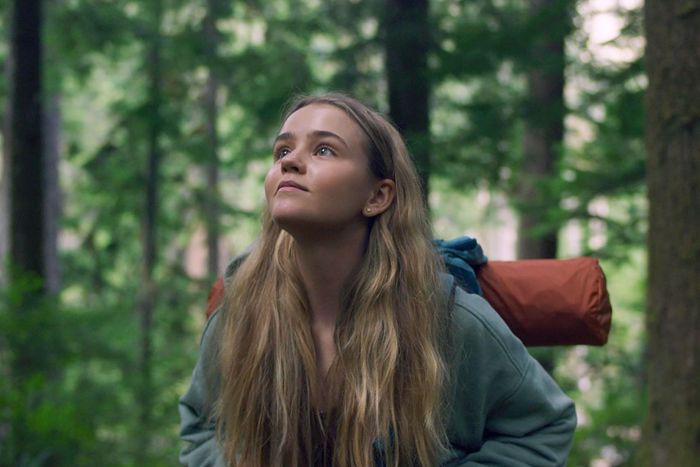
Penelope, the new YA Netflix series from Mel Eslyn and Mark Duplass, operates with the slight unreality of a fable. It follows a 16-year-old girl played by Little Fires Everywhere’s Megan Stott as she abruptly breaks from society and disappears into the gorgeous Pacific Northwest wilderness. We watch as Penelope grows into capability: She starts out barely knowing how to tie a knot but soon figures out how to last a night, then a week, then an uncertain amount of time. It’s never clear why she does this; the series only gestures at a feeling. The first episode opens with her at a silent dance party in what appears to be a summer camp. She’s in her own world, headphones on, surrounded by other kids constantly on their phones — until she spots a wolf, which sparks something in her.
As the teenager persists in the woods, Penelope periodically returns to hints of her inner life, but never with specificity. “I’m worried there’s a piece deep inside of me that’s broken,” she says later, while spending time with an older environmental activist protecting a tree. “That there’s this massive hole I’m never going to fill.” At one point, she wonders aloud: Was she ever a happy kid? The largely unexplained nature of Penelope’s emotional engine is magnetic and, for the most part, feels like an expression of truth: The anxiety and heaviness of being a teenager is often difficult to articulate, exponentially more so in the era of extreme digital ubiquity. Working at this frequency, Penelope feels like a revelation. But the elliptical power of the show is also why its shock ending is so deeply frustrating, as it undermines the ambition of just about everything that came before.
After eight episodes that follow the teenager surviving in the wilderness and encountering strangers who each aid in her coming of age, she begins to struggle with solitude as the weather grows colder. There’s a close call when she’s attacked by a cougar, though she survives without any grievous wounds or apparent threat of infection. Still, she faces dwindling resources, so she decides to trek back to civilization for supplies but collapses before she can make it. After waking in a small-town hospital and speaking to an exceedingly permissive social worker, rebuffing opportunities to return to her past life, she spends some time in town recuperating. One night, driven to seek out one of the strangers she met in her odyssey (a Christian teen for whom she develops romantic feelings), she heads to a library to use a computer. There she logs on to a social-networking site where, scrolling through her profile, she sees posts appealing for her return — and messages of condolences. That’s when she arrives at a picture of her parents posted sometime in the past two weeks, with the OP writing “I’m still in shock.” Another comment confirms the punch: “RIP.”
There’s a blink-and-you’ll-miss quality to the revelation. Penelope scrolls through her profile somewhat quickly, so a viewer might miss the timestamp of the post and subsequently interpret the information of her parents’ deaths to be retroactive. Such a reading would reframe the entire series as a kind of grief response: The teenager disappears into the woods to mourn her parents. But unless you can successfully stretch so far as to interpret the entire series as taking place under a week — and you truly can’t — then the sequencing of their deaths during her time in the wild means this Penelope becomes the story of a young girl who suffers an immeasurable loss during a period of radical self-discovery. The final moment of the season is a shot that lingers on Penelope’s face as she processes the news. Her reaction is quiet, a little inscrutable, before the screen cuts to black.
It’s a frustrating, conventional cliffhanger to what was otherwise a remarkably unconventional show. For the bulk of its run, Penelope comes across like an experiment that sought to grapple with the amorphous, hard-to-articulate yet near-universal experience of teenage malaise. This is a complicated enterprise, but the ambition is thrilling. There are luxurious stretches of quiet with not very much happening, so much so that they will probably register as boring to many viewers. The young Stott, armed with an open face and a natural charisma, is never quite believable as a teenager who would reject modernity, yet the clash of an obvious theater kid finding joy in the wild is kind of the point. Yes, the unreality of Penelope’s fable-like frequency can be discombobulating; seasoned outdoors enthusiasts and Alone heads will probably pull their hair out at the lack of realistic detail. Penelope miraculously figures out how to build a workable survival shelter despite being a young novice. Everyone she meets in her journey is generous and well-meaning. Malnourishment barely registers as a threat, her clothes always seem to dry, she never catches a cold. There’s even an early stretch when she spends time with a bear cub, something that any person who’s visited a zoo knows to run far, far away from. A viewer who sticks through to the end is probably already committed to the show’s idiosyncratic nature. Why not stay the course and leave Penelope within the realm of ambiguous alienation?
The series arrives at the right time for its subject. Concerns around the lives of young people in an age of smartphones and social media, what’s been short-handed by the author Jonathan Haidt as “The Anxious Generation” in a buzzy so-titled book from earlier this year, continue to grow. Efforts to ban smartphone use in schools are driving political and parental debates, while Instagram, a dominant force in young lives, conceded last month to safety concerns and made teenagers’ accounts private by default. FX is currently airing a new docuseries, Social Studies, which offers an extended look at a year in the life of several Los Angeles–area high-school students primarily through the lens of how they’re shaped, and hurt, by social media. In its own quiet way, Penelope slides neatly into this conversation as a story about a teenager who chafes against technological modernity as she searches for some sort of existential wholeness. She sees the digitally interconnected world around her and responds by dramatically embracing the physical one instead. So many uncommon thematic questions emerge from this idea: What does it mean to be unplugged in this era? What is the magic that’s been forgotten in this world? Is nature enough? But capping off Penelope’s odyssey with the death of her parents decimates the bigness of these questions, narrowing her story into one of a specific trauma.
Yet it’s hard to hold even a cheap, small ending against a show that feels so vast with so little. Penelope was financed out of pocket by Duplass using money from his Morning Show gig, making it an exceedingly rare example of a piece of independent television. Duplass, Eslyn, and the former’s brother Jay (also listed as a producer on the show), collectively run Duplass Brothers Productions and have long been part of independent film movements that made small, specific works about small, specific lives, including TV work for HBO (the lovely Somebody Somewhere and the cryptic anthology series Room 104) and Netflix (the early docuseries hit Wild Wild Country). Penelope marks what is perhaps the boldest iteration of the Duplasses’ television work, and the low-budget nature of its creation is almost certainly the reason why the show is so refreshing. Eslyn and Duplass have made something strange and special in Penelope, and we’d be so lucky if there were more things on television like it. Especially if their endings live up to their promise.


